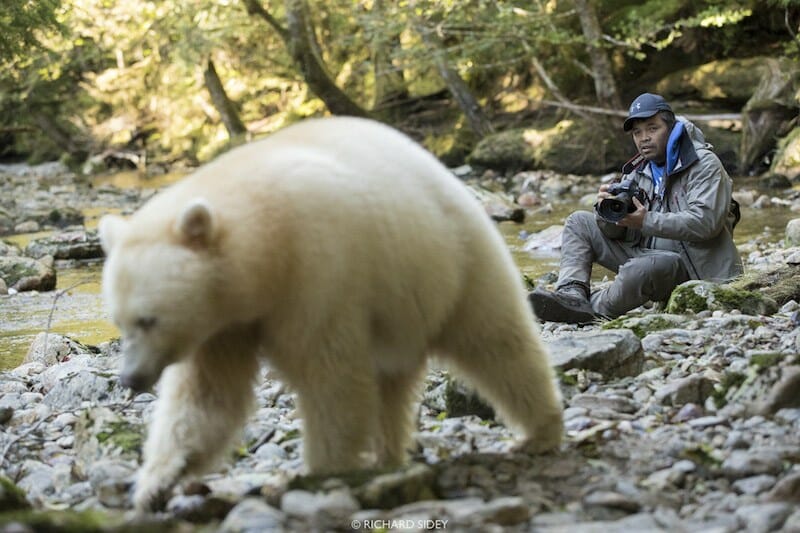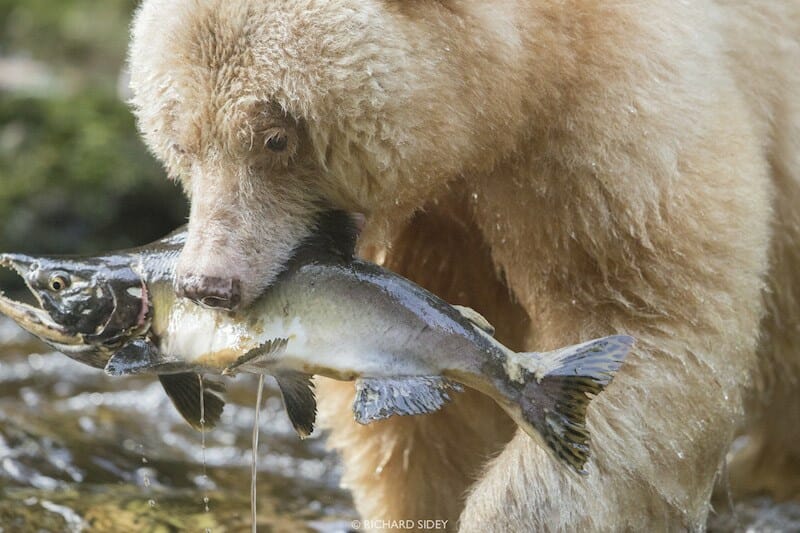Estimated Reading time

2 Mins
Spirit Bears in Gitga’at Territory

The following is an excerpt from Forest Spirits: Encounters with Ghosts in the Great Bear Rainforest, published in SevenSeas Magazine, written by Richard Sidey.
It’s early October and autumn has seemingly arrived overnight in the Great Bear Rainforest. It’s a brisk morning, still dark and there’s frost underfoot, clinging to the labyrinth of boardwalks that connect the dwellings in the small Gitga’at First Nation community of Hartley Bay. The ‘street’ lights appear suspended in a dense morning fog that has silently flowed down a river valley to the coastline where Hartley Bay is situated.
Our guide, Hartley Bay resident Marven Robinson, is already at the town docks which his boat Gitga’at Spirit fuelled up for the day’s journey. Marven is a renowned guide and bear whisperer, who has been sharing the Gitga’at Nation’s unique white bears with outsiders for twenty-two years. With quiet anticipation our group of ecologists, naturalists and photographers board his vessel and shortly afterwards we are making our way out of the harbour as the first rays of sunlight penetrate the thick fog. With the community in our wake two Humpback whales surface close to the shoreline, their blows creating rainbows in the morning light.
We reach a stretch of river known to be popular with the island’s bears. It appears vacant for now but we are surrounded by signs of bear activity, including traces of fur, piles of scat and numerous half-eaten fish carcasses deposited along the river bed and into the surrounding forest. We unpack our camera equipment, pick a good vantage point along the riverbank and settle in for what generally defines most wildlife photography experiences, the art of patience.

The white, black bear I am hoping to view and photograph goes by several names. Most commonly they are known as the Spirit bear, a romantic alternate to the Kermode Bear, named after Frank Kermode, a former director of the Royal BC Museum. Ursus americanus kermodei is the latin name. To the Gitga’at First Nation they are known as Moksgm’ol, the Ghost Bear. These are a subspecies of American black bear, which have white fur when they carry a double-recessive gene unique to their subspecies. It is estimated that fewer than 400 Spirit/Kermode/Ghost bears are currently in existence.
I ask Marven if there is a local mythology explaining the significance of Moksgm’ol. “The creator, the Raven,” he explains, “asked the Black bear to make one-in-ten cubs white, to serve as a reminder of when the world was covered in ice.” He tells me his Grandmother used to point out that a Black bear would be no good on the ice. “And if you look closely at some photographs”, he adds, “look at the feet. The toes of the white bear are longer than the Black bears. There are more genetic differences than simply the white fur.”
Read more about Moksgm’ol and Richard Sidey’s experience photographing Spirit bears in Gitga’at territory at SevenSeas Magazine.
